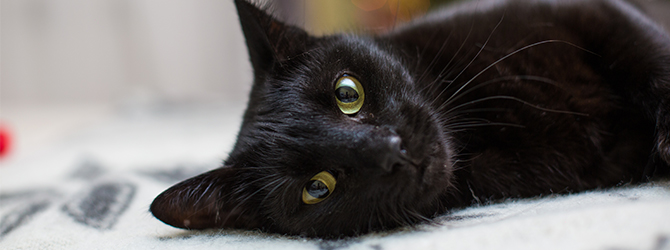Cataracts in cats: does my cat have cataracts?
A cataract is an eye condition, namely an opacity on the lens that causes blurry vision in humans, cats and other animals. Cataracts are less common in cats than in dogs or humans. However, as cataracts can lead to glaucoma and even blindness over time, they’re important to diagnose and monitor. But what causes cataracts in cats – and what can be done for a cat with this condition? We’ve got the lowdown.
What are the causes of cataracts in cats?
In humans, cataracts are usually a sign of ageing. In cats, this isn’t always the case. Cataracts can develop as a result of disease – they can occur secondary to chronic uveitis (an inflammatory condition of the eye) or glaucoma. They can also be caused by an injury to the eye or secondary to diabetes. – It is also possible for cataracts to be inherited although this is rare.
It can be helpful to know your cat’s full family medical history, so that you can be alert to any changes to the eyes if she’s at greater risk of developing cataracts.
Common causes of cataracts in cats
- Chronic uveitis (a form of inflammation of the eye)
- Glaucoma
- Lens luxation
- Diabetes mellitus
- Malnutrition as a kitten
- Blunt trauma
- Penetrating injury to the eye, commonly caused by fighting with other cats
- Low calcium and other nutritional disorders
- Electric shock
- Exposure to radiation or toxic substances
How do I know if my cat is developing cataracts?
Your cat’s eyes are likely to become cloudy-looking or develop a grey-blue tinge as she gets older. This condition is called nuclear sclerosis. It’s common in cats aged over seven and is caused by normal aging of the lens. It should not affect your cat’s vision or cause any pain. Cataracts can look similar to nuclear sclerosis and cataracts to require veterinary attention.
The only way to tell whether cloudiness of the lens is caused by cataracts or nuclear sclerosis is to take your cat to the vet for a check-up. As cataracts are degenerative, early diagnosis may be able to stop the progression of the disease, so don’t put off that appointment!
If your cat has diabetes, other signs she may be developing cataracts include increased thirst, increased urination, and weight loss.
“It can be helpful to know your cat’s full family medical history, so that you can be alert to any changes to the eyes if she’s at greater risk of developing cataracts.”
How are cataracts in cats diagnosed?
Your vet will carry out a simple but thorough examination of your cat’s eyes. If they believe cataracts are developing, they will refer you to a veterinary ophthalmologist who can determine the severity of the condition and recommend ways to monitor and manage the problem.
Can I prevent cataracts in my cat?
Cataracts in cats can’t be prevented, but there are things you can do to take care of your cat’s vision that may help:
- Examine your cat’s eyes regularly
- Take her to your local vet if her eyes begin to look cloudy or grey-blue in colour
- Take your cat to the vet if you notice any changes in her vision
- Some experts believe a nutritious diet that’s high in antioxidants can delay or even prevent cataracts
Treatment and cataract surgery for cats
Developments in modern medicine mean the outlook for cats with cataracts is positive. Your vet may decide to treat inflammation of the eye with special eye drops, but if your cat has already lost her vision due to cataracts, surgery may be an option.
Veterinary ophthalmologists may be able to restore lost vision through surgery, in which they replace the infected lens with an acrylic or plastic lens.
Cataract surgery requires careful post-operative care, but the procedure has a pretty good success rate. Your vet may recommend surgery if he or she believes it can help to restore your cat’s eyesight.
Need more information on cataracts in cats?
For expert advice on cataracts in cats, or any aspect of your pet’s health, contact your local vet.
Find your nearest vet using our Find a Vet page, or speak to a vet online using Online Vets.

